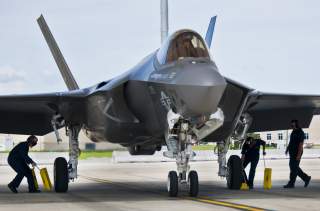Get Ready, China and North Korea: The F-35C Is Headed to Japan
After 2021, the new plane will arrive.
The United States Navy is expected to deploy the Lockheed Martin F-35C Joint Strike Fighter to Japan after 2021 as part of an enhanced deterrence posture against China. According to a Japanese news report in the Yomiuri Shimbun, the Navy will deploy the stealthy single-engine strike aircraft to Marine Corps Air Station Iwakuni.
“Carrier Air Wing [CVW] 5 ... will receive the F-35C Lightning II sometime after 2021,” a U.S. Navy official told the Yomiuri Shimbun. “The F-35C’s [squadrons] will forward deploy to MCAS Iwakuni.”
The F-35C squadron will replace one of CVW-5’s Boeing F/A-18E/F Super Hornets squadrons, which are currently based at Naval Air Station Atsugi near Tokyo. The Navy is reducing the number of aircraft based at Atsugi by 60 planes. “When the first F-35C squadron forward deploys to Iwakuni, it will replace an F/A-18 Super Hornet squadron,” a Navy official told the Yomiuri Shimbun.
Recommended: The 5 Biggest Nuclear Bomb Tests (From All 6 Nuclear Powers).
Recommended: How Israel Takes U.S. Weapons and Makes Them Better.
Recommended: North Korea’s Most Lethal Weapon Isn’t Nukes.
The Navy likely chose to move the F-35C unit to Iwakuni because the U.S. Marine Corps already bases its short takeoff vertical landing (STOVL) F-35B aircraft at the base. Thus, most of the facilities needed to sustain F-35C operations already exist at Iwakuni, reducing the need to build more infrastructure.
The F-35C is set to make its first operational deployment onboard the aircraft carrier USS Carl Vinson in 2021. The Navy is set to formally declare the jet operational in 2019 once the Block 3F software block, which including the F-35’s full functionality, undergoes operational testing—which is somewhat later then an expected initial operational capability date in late 2018.
“The whole F-35 enterprise’s IOT&E starts in September, so it’s not Navy F-35C that’s holding up IOC, it’s that we’re tied to IOT&E and need to see the demonstration and capabilities. We need to really see the 3F capability demonstrated in IOT&E and there’s just not going to be enough time to see enough of that before Feb. 2019,” Rear Adm. Dale Horan, the Navy’s director of Joint Strike Fighter Fleet Integration, told the United States Naval Institute News. “It’s DoD’s opportunity to test drive their new airplane.”
However, given that the Navy does not believe that the slight delay in declaring the F-35C operational should impact the 2021 deployment onboard Carl Vinson, there should not be an impact on stationing the aircraft in Japan either. “I don’t see any significant barriers to first deployment,” Horan told the Naval Institute. “We have plenty of work to do. Getting a new aircraft into the fleet will always be a complex issue.”
That the Navy would choose to deploy the F-35C to Japan after the 2021 should not be a surprise. Japan is close to China, Russia and North Korea, thus, the jet’s presence serves as a peacetime deterrent against other powers. However, if push ever came to shove, the F-35C would offer a potent penetrating strike capability against the targets in all three of those countries.
Dave Majumdar is the defense editor for The National Interest. You can follow him on Twitter: @davemajumdar.

